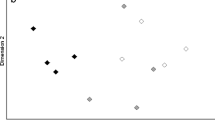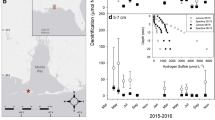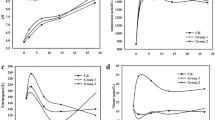Abstract
An important source of new nitrogen in salt marsh ecosystems is microbial diazotrophy (nitrogen fixation). The diazotroph assemblages associated with the rhizospheres (sediment directly affected by the roots) of salt marsh plants are highly diverse, somewhat stable, and consist mainly of novel organisms. In Crab Haul Creek Basin, North Inlet, SC, the distribution of plant types into discrete zones is dictated by relatively minor differences in marsh elevation and it was hypothesized that the biotic and abiotic properties of the plant zones would also dictate the composition of the rhizosphere diazotroph assemblages. Over a period of 1 year, rhizosphere sediments were collected from monotypic stands of the black needlerush, Juncus roemerianus, the common pickleweed, Salicornia virginica, the short and tall growth forms of the smooth cordgrass Spartina alterniflora, and a mixed zone of co-occurring S. virginica and short form, S. alterniflora. DNA was extracted, purified and nifH sequences PCR amplified for denaturing gradient gel electrophoresis (DGGE) analysis to determine the composition of the diazotroph assemblages. The diazotroph assemblages were strongly influenced by season, abiotic environmental parameters and plant host. Sediment chemistry and nitrogen fixation activity were also significantly influenced by seasonal changes. DGGE bands that significantly affected seasonal and zone specific clustering were identified and most of these sequences were from novel diazotrophs, unaffiliated with any previously described organisms. At least one third of the recovered nifH sequences were from a diverse assemblage of Chlorobia, and γ-, α-, β- and δ-Proteobacteria. Diazotrophs that occurred throughout the growing season and among all zones (frequently detected) were also mostly novel. These significant sequences indicated that diazotrophs driving the structure of the assemblages were diverse, versatile, and some were ubiquitous while others were seasonally responsive. Several ubiquitous sequences were closely related to sequences of actively N2 fixing diazotrophs previously recovered from this system. These sequences from ubiquitous and versatile organisms likely indicate the diazotrophs in these rhizosphere assemblages that significantly contribute to ecosystem function.




Similar content being viewed by others
References
Adam P (1990) Saltmarsh ecology. Cambridge University Press, Cambridge, p 461
Adams DA (1963) Factors influencing vascular plant zonation in North Carolina salt marshes. Ecology 44:445–456
Anderson CE (1974) A review of structure in several North Carolina salt marsh plants. In: Reimold RJ, Queen WH (eds) Ecology of Halophytes. Academic Press Inc, New York, pp 307–344
Bagwell CE, Lovell CR (2000) Microdiversity of culturable diazotrophs from the rhizoplanes of the salt marsh grasses Spartina alterniflora and Juncus roemerianus. Microb Ecol 39:128–136
Bagwell CE, Lovell CR (2000) Persistence of selected Spartina alterniflora rhizoplane diazotrophs exposed to natural and manipulated environmental variability. Appl Environ Microbiol 66:4625–4633
Bagwell CE, LaRocque JR, Smith GW, Polson SW, Friez MJ, Longshore JW, Lovell CR (2002) Molecular diversity of diazotrophs in oligotrophic tropical seagrass bed communities. FEMS Microbiol Ecol 39:113–119
Bagwell CE, Dantzler M, Bergholz PW, Lovell CR (2001) Host-specific ecotype diversity of rhizoplane diazotrophs of the perennial glasswort Salicornia virginica and selected salt marsh grasses. Aquat Microb Ecol 23:293–300
Bagwell CE, Piceno YM, Ashburne-Lucas A, Lovell CR (1998) Physiological diversity of the rhizosphere diazotroph assemblages of selected salt marsh grasses. Appl Environ Microbiol 64:4276–4282
Bergholz PW, Bagwell CW, Lovell CR (2001) Physiological diversity of rhizoplane diazotrophs of the saltmeadow cordgrass, Spartina patens: Implications for host specific ecotypes. Microb Ecol 42:466–476
Bertness MD (1991) Zonation of Spartina patens and Spartina alterniflora in New England salt marsh. Ecology 72:138–148
Bertness MD, Ellison AM (1987) Determinants of pattern in a New England salt marsh plant community. Ecol Monogr 57:129–147
Blood ER, Vernberg FJ (1992) Characterization of the physical, chemical, and biological conditions and trends in Winyah Bay and North Inlet estuaries: 1970–1985 In: Characterization of the physical, chemical, and biological conditions and trends in three South Carolina Estuaries. Winyah Bay and North Inlet Estuaries, vol. II. SC Sea Grant Consortium, Charleston. pp. 162
Boyle CD, Patriquin DG (1981) Carbon metabolism of Spartina alterniflora Loisel in relation to that of associated nitrogen-fixing bacteria. New Phytol 89:275–288
Bradley PM, Morris JT (1991) The influence of salinity on the kinetics of NH +4 uptake in Spartina alterniflora. Oecologia 85:375–380
Brown DM, Lin PKT (1991) Synthesis and duplex stability of oligonucleotides containing adenine-guanine analogues. Carbohydr Res 216:129–139
Brown MM, Friez MJ, Lovell CR (2003) Expression of nifH genes by diazotrophic bacteria in the rhizosphere of short form Spartina alterniflora. FEMS Microbiol Ecol 43:411–417
Dai T, Wiegert RG (1997) A field study of photosynthetic capacity and its response to nitrogen fertilization in Spartina alterniflora. Estuar Coast Shelf Sci 45:273–283
Dame R, Chrzanowski T, Bildstein K, Kjerfve B, McKellar H, Nelson D, Spurrier J, Stancyk S, Stevenson H, Vernberg J, Zingmark R (1986) The outwelling hypotheis and North Inlet, South Carolina. Mar Ecol Prog Ser 33:217–229
Fromin N, Hamelin J, Tarnawski S, Roesti D, Jourdain-Miserez K, Forestier N, Teyssier-Cuvelle S, Gillet F, Aragno M, Rossi P (2002) Statistical analysis of denaturing gradient gel electrophoresis (DGE) fingerprinting patterns. Environ Microbiol 4:634–643
Gamble MD, Bagwell CE, LaRocque J, Bergholz PW, Lovell CR (2010) Seasonal variability of diazotroph assemblages associated with the rhizosphere of the salt marsh cordgrass, Spartina alterniflora. Microb Ecol 59:253–265
Gandy EL, Yoch DC (1988) Relationship between nitrogen-fixing sulfate reducers and fermenters in salt marsh sediments and roots of Spartina alterniflora. Appl Environ Microbiol 54:2031–2036
Hanson RB (1983) Nitrogen fixation activity (acetylene reduction) in the rhizosphere of salt marsh angiosperms, Georgia, U.S.A. Bot Mar 26:49–59
Hines ME, Evans RS, Sharak-Genthner BR, Willis SG, Friedman S, Rooney-Varga JN, Devereaux R (1999) Molecular phylogenetic and biogeochemical studies of sulfate-reducing bacteria in the rhizosphere of Spartina alterniflora. Appl Environ Microbiol 65:2209–2216
Hopkinson CS, Schubauer JP (1984) Static and dynamic aspects of nitrogen cycling in the salt marsh graminoid Spartina alterniflora. Ecology 65:961–969
Howes BL, Teal JM (1994) Oxygen loss from Spartina alterniflora and its relationship to salt marsh oxygen balance. Oecologia 97:431–438
Jones K (1974) Nitrogen fixation in a salt marsh. J Ecol 62:553–565
Keefe CW (1972) Marsh production: a summary of the literature. Contrib Mar Sci 16:163–181
King GM (1988) Patterns of sulfate reduction and the sulfur cycle in a South Carolina salt marsh. Limnol Oceanogr 33:376–390
Koretsky CM, Moore CM, Lowe KL, Meile C, Dichristina TJ, Van Cappellen P (2003) Seasonal oscillation of microbial iron and sulfate reduction in saltmarsh sediments (Sapelo Island, GA, USA). Biogeochemistry 64:179–203
GB LMA, Brown NP, Chenna R, McGettigan PA, McWilliam H, Valentin F, Wallace IM, Wilm A, Lopez R, Thompson JD, Gibson TJ, Higgins DG (2007) Clustal W and Clustal X version 2.0. Bioinformatics 23:2947–2948
LaRocque JR, Bergholz PW, Bagwell CE, Lovell CR (2004) Influence of host plant-derived and abiotic environmental parameters on the composition of the diazotroph assemblage associated with roots of Juncus roemerianus. Anton van Leeuwen 86:249–261
Lin PKT, Brown DM (1989) Synthesis and duplex stability of oligonucleotides containing cytosine-thymine analogues. Nucleic Acids Res 17:10373–10383
Livingstone DC, Patriquin DG (1980) Nitrogenase activity in relation to season, carbohydrates and organic acids in a temperate zone root association. Soil Biol Biochem 12:543–546
Lovell CR, Piceno Y (1994) Purification of DNA from estuarine sediments. J Microbiol Meth 20:161–174
Lovell CR, Bagwell CE, Czako M, Marton L, Piceno YM, Ringelberg DB (2001) Stability of a rhizosphere microbial community exposed to natural and manipulated environmental variability. FEMS Microbiol Ecol 38:69–76
Lovell CR, Friez MJ, Longshore JW, Bagwell CE (2001) Recovery and phylogenetic analysis of nifH sequences from diazotrophic bacteria associated with dead aboveground biomass of Spartina alterniflora. Appl Environ Microbiol 67:5308–5314
Lovell CR, Decker PV, Bagwell CE, Thompson S, Matsui GY (2008) Analysis of a diverse assemblage of diazotrophic bacteria from Spartina alterniflora using DGGE and clone library screening. J Microbiol Meth 73:160–171
Lovell CR, Piceno YM, Quattro JM, Bagwell CE (2000) Molecular analysis of diazotroph diversity in the rhizosphere of the smooth cordgrass, Spartina alterniflora. Appl Environ Microbiol 66:3814–3822
Marinucci AC, Hobbie JE, Helfrich JVK (1983) Effect of litter nitrogen on decomposition and microbial biomass in Spartina alterniflora. Microb Ecol 9:27–40
McClung CR, Patriquin DG, Davis RE (1983) Campylobacter nitrofigilis sp. nov., a nitrogen-fixing bacterium associated with roots of Spartina alterniflora Loisel. Int J Syst Bacteriol 33:605–612
McClung CR, van Berkum P, Davis RE, Sloger C (1983) Enumeration and localization of N2-fixing bacteria associated with roots of Spartina alterniflora Loisel. Appl Environ Microbiol 45:1914–1920
Mendelssohn IA (1979) Nitrogen metabolism in the height forms of Spartina alterniflora in North Carolina. Ecology 60:574–584
Morris JT (1991) Effects of nitrogen loading on wetland ecosystems in particular reference to atmospheric deposition. Ann Rev Ecolog Syst 22:257–279
Morris JT (2010) Long-term studies of salt marsh primary production. Available at: http://www.biol.sc.edu/~morris/annprod.html. Access 10 Mar 2010
Morris JT, Haskin B (1990) A 5-yr record of aerial primary production and stand characteristics of Spartina alterniflora. Ecology 71:2209–2217
Morris JT, Sundareshwar PV, Nietch CT, Kjerfve B, Cahoon DR (2002) Responses of coastal wetlands to rising sea level. Ecology 83:2869–2877
NIWNERRMET (2001) North Inlet Winyah Bay National Estuarine Research Reserve Meterological Data. Available at: http://links.baruch.sc.edu/Data/LongTermData.html. Access 10 Mar 2010
Patriquin DG (1978) Nitrogen fixation (acetylene reduction) associated with cord grass, Spartina alterniflora Loisel. Ecol Bull 26:20–27
Pennings SC, Callaway RM (1992) Salt marsh zonation: the relative importance of competition and physical factors. Ecology 73:681–690
Piceno YM, Lovell CR (2000) Stability in natural bacterial communities: I. Nutrient addition effects on rhizosphere diazotroph assemblage composition. Microb Ecol 39:32–40
Piceno YM, Lovell CR (2000) Stability in natural bacterial communities: II. Plant resource allocation effects on rhizosphere diazotroph assemblage composition. Microb Ecol 39:41–48
Piceno YM, Noble PA, Lovell CR (1999) Spatial and temporal assessment of diazotroph assemblage composition in vegetated salt marsh sediments using denaturing gradient gel electrophoresis. Microb Ecol 38:157–167
Rooney-Varga JN, Devereux R, Evans RS, Hines ME (1997) Seasonal changes in the relative abundance of uncultivated sulfate-reducing bacteria in a salt marsh sediment in the rhizosphere of Spartina alterniflora. Appl Environ Microbiol 63:3895–3901
Schubauer JP, Hopkinson CS (1984) Above- and belowground emergent macrophyte production and turnover in a coastal marsh ecosystem, Georgia. Limnol Oceanogr 29:1052–1065
JD TK, Nei M, Kumar S (2007) Molecular Evolutionary Genetics Analysis (MEGA) software version 4.0. Mol Biol Evol 24:1596–1599
Teal JM, Valiela I, Berlo D (1979) Nitrogen fixation by rhizosphere and free-living bacteria in salt marsh sediments. Limnol Oceanogr 24:126–132
Thompson JD, Gibson TJ, Plewniak F, Jeanmougin F, Higgins DG (1997) The Clustal X windows interface: flexible strategies for multiple sequence alignment aided by quality analysis tools. Nucleic Acids Res 25:4876–4882
Thompson SP, Paerl HW, Go MC (1995) Seasonal patterns of nitrification and denitrification in a natural and restored salt marsh. Estuaries 18:399–408
Trüper HG, Schlegel HG (1964) Sulphur metabolism in Thiorhodaceae I. Quantitative measurements on growing cells of Chromatium okenii. Anton van Leeuwen 30:225–238
Turner RE (1976) Geographic variations in salt marsh macrophyte production: a review. Contrib Mar Sci 20:47–68
Valiela I, Teal JM (1974) Nutrient limitation in salt marsh vegetation. In: Reimold RJ, Queen WH (eds) Ecology of Halophytes. Academic Press, Inc, New York, pp 547–563
Valiela I, Teal JM, Volkmann S, Shafer D, Carpenter EJ (1978) Nutrient and particulate fluxes in a salt marsh ecosystem: tidal exchanges and inputs by precipitation and groundwater. Limnol Oceanogr 23:798–812
van Wijnen HJ, Bakker JP (1999) Nitrogen and phosphorous limitation in a coastal barrier salt marsh: the implications for vegetation succession. J Ecol 87:265–272
Venter JC, Remington K, Heidelberg JF, Halpern AL, Rusch D, Eisen JA, Wu D, Paulsen I, Nelson KE, Nelson W, Fouts DE, Levy S, Knap AH, Lomas MW, Nealson K, White O, Peterson J, Hoffman J, Parsons R, Baden-Tillson H, Pfannkoch C, Rogers Y, Smith HO (2004) Environmental genome shotgun sequencing of the Sargasso Sea. Science 304:66–74
Welsh A, Burke DJ, Hahn D (2007) Analysis of nitrogen-fixing members of the ε-subclass of Proteobacteria in salt marsh sediments. Appl Environ Microbiol 73:7747–7752
Whiting GJ, Gandy EL, Yoch DC (1986) Tight coupling of root-associated nitrogen fixation and plant photosynthesis in the salt marsh grass Spartina alterniflora and carbon dioxide enhancement of nitrogenase activity. Appl Environ Microbiol 52:108–113
Yoch DC, Whiting GY (1986) Evidence for NH +4 switch-off regulation of nitrogenase activity by bacteria in salt marsh sediments and roots of the grass Spartina alterniflora. Appl Environ Microbiol 51:143–149
Young J (1992) Phylogenetic classification of nitrogen-fixing organisms. In: Stacey G, Burris RH, Evans HJ (eds) Biological nitrogen fixation. Chapman and Hall, Inc, New York, pp 43–86
Acknowledgements
We acknowledge the Belle W. Baruch Institute for Coastal and Marine Sciences for access to sampling sites and for logistical support and the Environmental Genomics Core facility at the University of South Carolina for assistance with DNA sequencing. We also acknowledge Xiaobo Zhou for collection of elevation data and site mapping. This research was supported by the National Science Foundation award MCB-0237854 to C.R.L. Contribution 1619 to the Belle W. Baruch Institute for Coastal and Marine Sciences.
Author information
Authors and Affiliations
Corresponding author
Electronic Supplementary Material
Below is the link to the electronic supplementary material.
Figure 1
a PCA results for dates June (SS, JP, S and T) and September 2000 (SV, SS, S and T). Circles denote significance (p < 0.001) for clustering. For June 2000 axis 1 represents 28.4% of the variance and axis 2 represents 14.7% of the variance. For September 2000 axis 1 represents 31.5% of the variance and axis 2 represents 11.5% of the variance (GIF 67 kb). b PCA results for April 2001 (JS, SV, SS, S and T). Circles denote significance (p < 0.001) for clustering. For April 2001 axis 1 represents 25.9% of the variance and axis 2 represents 21.2% of the variance (GIF 28 kb)
Figure 2
a PCA results for Salicornia virginica and mixed (S. virginica/Short form S. alterniflora—SS) plant zone on all dates. Circles denote significance (p < 0.001) for clustering. For S. virginica axis 1 represents 33.6% of the variance and axis 2 represents 26.4% of the variance. For S. virginica/Short form S. alterniflora axis 1 represents 24.5% of the variance and axis 2 represents 17.3% of the variance (GIF 66 kb). b PCA results for Juncus roemerianus patch (JP) and short form S. alterniflora (S) for all dates. Circles denote significance (p < 0.001) for clustering. For J. roemerianus patch axis 1 represents 24.7% of the variance and axis 2 represents 22.1% of the variance. For short form S. alterniflora, axis 1 represents 25.8% of the variance and axis 2 represents 12.6% of the variance (GIF 71 kb)
Figure 3
a, b Phylogram of sequences from rhizosphere samples, frequently detected (FD) and longest eigenvector (LV) sequences, nifH mRNA sequences, and seasonally responsive and non-responsive sequences (nucleotide sequences, neighbor-joining, Jukes–Cantor correction, 1,000 bootstrap replicates, complete deletion of gaps and missing data). Sequences with GenBank accession numbers beginning with AY are nifH mRNA sequences from Brown et al. [16] and accession numbers beginning with FJ are seasonally responsive and non-responsive sequences from Gamble et al. [20] a (GIF 61 kb), b (GIF 135 kb)
Rights and permissions
About this article
Cite this article
Davis, D.A., Gamble, M.D., Bagwell, C.E. et al. Responses of Salt Marsh Plant Rhizosphere Diazotroph Assemblages to Changes in Marsh Elevation, Edaphic Conditions and Plant Host Species. Microb Ecol 61, 386–398 (2011). https://doi.org/10.1007/s00248-010-9757-8
Received:
Accepted:
Published:
Issue Date:
DOI: https://doi.org/10.1007/s00248-010-9757-8




